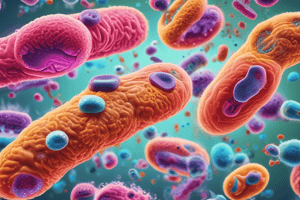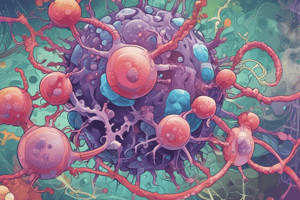Podcast
Questions and Answers
What is microbiology?
What is microbiology?
- Study of living organisms
- Study of human diseases
- Study of tiny microbes (correct)
- Study of bacteria only
Eukaryotes include bacteria.
Eukaryotes include bacteria.
False (B)
What are the two main classifications of organisms based on the electron microscope?
What are the two main classifications of organisms based on the electron microscope?
Prokaryotes and Eukaryotes
Bacteria that are spherical in shape are called ______.
Bacteria that are spherical in shape are called ______.
Match the following bacterial shapes with their names:
Match the following bacterial shapes with their names:
What unique structure do Gram-negative bacteria possess that gram-positive bacteria do not?
What unique structure do Gram-negative bacteria possess that gram-positive bacteria do not?
The cell wall of bacteria is considered essential for their life.
The cell wall of bacteria is considered essential for their life.
Which of the following is a characteristic of the cell wall in Gram-positive bacteria?
Which of the following is a characteristic of the cell wall in Gram-positive bacteria?
The major antigen of the bacterial cell wall is called ______.
The major antigen of the bacterial cell wall is called ______.
What antibiotic target involves the cell wall?
What antibiotic target involves the cell wall?
Flashcards
Prokaryotic Cell
Prokaryotic Cell
A single-celled organism lacking a nucleus and membrane-bound organelles.
Eukaryotic Cell
Eukaryotic Cell
A complex cell with membrane-bound organelles and a nucleus.
Bacterial Cell Wall
Bacterial Cell Wall
A rigid outer layer that provides structure and protection.
Gram-positive Bacteria
Gram-positive Bacteria
Signup and view all the flashcards
Gram-negative Bacteria
Gram-negative Bacteria
Signup and view all the flashcards
Bacterial Morphology
Bacterial Morphology
Signup and view all the flashcards
Bacterial Arrangement
Bacterial Arrangement
Signup and view all the flashcards
Peptidoglycan
Peptidoglycan
Signup and view all the flashcards
Bacterial Capsule
Bacterial Capsule
Signup and view all the flashcards
Bacterial Flagella
Bacterial Flagella
Signup and view all the flashcards
Study Notes
General Bacteriology
- Microbiology is the study of small living organisms like bacteria, fungi, and viruses.
- Organisms are classified into prokaryotes (bacteria, rickettsia, chlamydia) and eukaryotes (fungi, protozoa, plant and animal cells). Viruses are also separate.
Bacterial Structure
- Bacteria have a capsule, cell wall, plasma membrane, nucleoid, cytoplasm, and ribosomes.
Comparing Prokaryotes and Eukaryotes
- Prokaryotes lack a nuclear membrane and nucleolus, while eukaryotes do not.
- Prokaryotic chromosomes are single and circular, while eukaryotic ones are multiple and linear.
- Prokaryotes do not have membrane-bound organelles (like mitochondria or Golgi), whereas eukaryotes do.
- Prokaryotic cell walls contain peptidoglycan (mostly). Plant also have cell wall, but composed of cellulose. Animal cells do not have cell wall.
- Bacteria ribosomes are 70S (30S and 50S subunits), eukaryotic ones are 80S (40S and 60S subunits).
- Prokaryotes reproduce via binary fission, eukaryotes do so through mitosis or budding.
Classification of Bacteria
- Bacteria are classified based on shape (coccus, bacillus, spirillum, spirochaete), arrangement (diplococci, streptococci, staphylococci), and staining characteristics (gram-positive and gram-negative).
Bacterial Cell Structure
- Essential components: cell wall, cytoplasmic membrane, protoplasm (cytoplasm + nuclear material).
- Accessory components: capsule and slime, fimbriae (pili), flagella, spores, plasmids.
- These accessory structural components enhance pathogenicity, meaning it increases the ability of the bacteria to cause disease.
Cell Wall
- Rigid structure maintaining bacterial shape and providing protection against osmotic lysis (especially in hypotonic solutions).
- Gram-positive cell walls are thick and contain peptidoglycans and teichoic acids, while gram-negative ones are thin, containing peptidoglycan and an outer membrane with lipopolysaccharides (LPS).
- LPS is an endotoxin highly toxic and can cause inflammation, fever, and shock.
- The cell wall is important for classification and a good target for antibiotics like penicillin and cephalosporins (inhibiting cell wall synthesis).
Cytoplasmic Membrane
- Structure: a semipermeable membrane around the cytoplasm maintaining a constant internal environment.
- Functions: selective permeability (active and passive transport), excretion of hydrolytic enzymes and toxins, respiration and ATP production, DNA replication, and cell wall biosynthesis.
Mesosomes
- Invaginations of the cytoplasmic membrane.
- Functions in respiration (contain respiratory enzymes) and cell division (forming septum).
Cytoplasm
- Viscous, watery substance containing various components, including cytoplasmic inclusion granules (e.g., meta-polyphosphate) and ribosomes.
- Ribosomes are sites of protein synthesis (70S in size).
Bacterial Nucleus
- Single, circular DNA molecule (supercoiled).
- Multiplication occurs via binary fission (separation of copies).
Capsule and Slime
- External layers (glycocalyx) surrounding the cell wall.
- Capsules are firmly attached and dense, while slime layers are loosely attached.
- Composition varies (polysaccharides, polypeptides, hyaluronic acid).
- Protects against phagocytosis, aids in attachment to surfaces (forming biofilms), and contributes to virulence.
Flagella
- Long, thin appendages extending from the cell surface.
- Composed of flagellin protein.
- Involved in bacterial motility and chemotaxis, enabling movement toward favorable conditions and away from harmful ones.
- Different arrangements (polar, lophotrichous, peritrichous).
Pili/Fimbriae
- Short, hair-like appendages.
- Composed of pilin protein.
- Primarily involved in adhesion to host cells for colonization, therefore enhance pathogenicity.
- Two types (ordinary pili and sex pili).
Spores
- Highly resistant, dormant structures produced by some bacteria (Gram-positive).
- Formed in adverse conditions (e.g., nutrient depletion, dryness).
- Resistant to heat, chemicals, and UV radiation due to specific structures (layers, calcium dipicolinate).
- Not actively multiplying, but can germinate to active vegetative cells when conditions improve.
- Importance for survival and disease transmission.
Plasmids
- Extrachromosomal, circular DNA molecules.
- Replicate independently of the bacterial chromosome. - Diverse functions, including:
- resistance to antibiotics (R-plasmids), toxins (virulence plasmids), conjugation, and genes for enzymes involved in nutrient utilization.
Studying That Suits You
Use AI to generate personalized quizzes and flashcards to suit your learning preferences.




